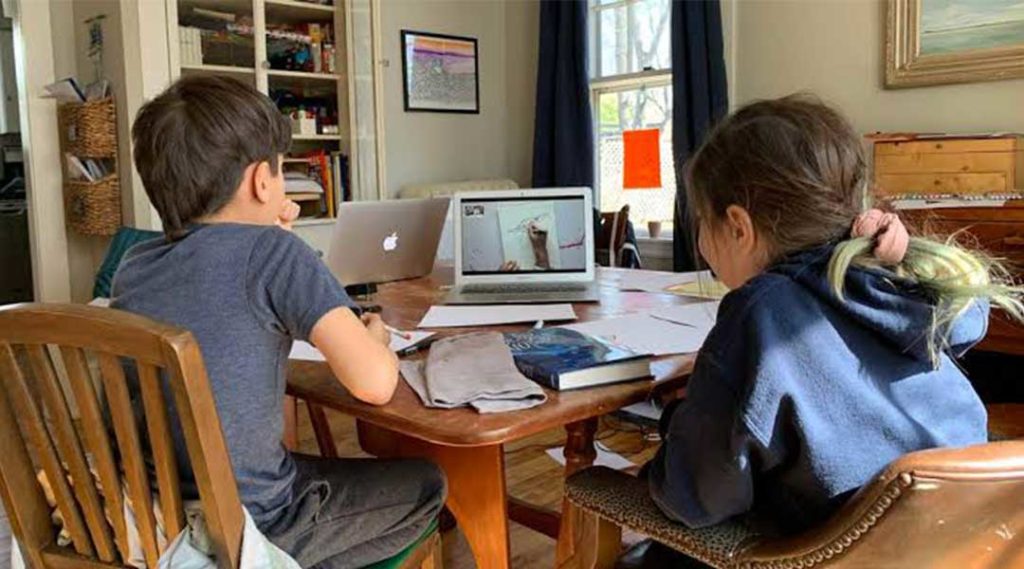Trending
Work-Life Balance Redefined: 10 tips on managing work from home and home-based learning
If you are a parent juggling working from home and managing your kids who are learning from home, how are you really doing? Between Zoom conference calls and work e-mails, Google Classroom, homework, and text messages all day long, does it feel like you need more than 24 hours a day?
Work-life balance has taken on a new meaning over the last six months. For most of us, pre-pandemic, being at home was already a much needed break from the daily grind. What was once a place for respite is now a classroom, office, mess hall, cafeteria rolled into one. What happened to our home and how exactly do we draw the lines?

Here are ten tips you can try to make your current setup less hectic.
1. Create daily schedules and make to-do lists for each family member.
The first step to creating breathing room is to get organized and see the big picture. The tasks you have to do for work and your kids’ tasks (that you have to manage) can be very overwhelming, so write them down. Explain the lists to everyone involved and hold them accountable for their deliverables. If your kids are younger, a simple to-do list will do. If your kids are older, you can categorize them according to school work, chores, extra curricular activities, etc. Parents, you are not exempt from a to-do list or a schedule. Working from home doesn’t mean working 24/7. To keep yourself on track and to avoid putting too much on your plate, this is crucial — for yourself and for your family so they know if you are in a meeting, doing something important or need help.
2. Create designated work spaces.
To make working and learning more conducive, assign a simple workspace for everyone. I have six kids doing online learning and I am working from home almost every day. I share my workspace (aka the masters bedroom) with my youngest daughter. If we both have to go on a Zoom call, she goes to the dining room. My five other kids are spread out around the house — their bedrooms, the attic, and as a backup, they can always retreat to the living room. You don’t have to tear down walls or remodel your home for this. A simple table and chair positioned in a corner or against a wall will work just fine. The key is to give everyone a designated space to go where they can learn and work. Meals should be eaten in the dining room or in the kitchen, not where you are working or where the kids are studying. Remember that if you want to draw lines, you have to start with designating spaces.

3. Start your day earlier and wake up before your kids.
The early bird always gets the worm, but in this case, the early bird always gets a head start. Gone are the days of manic mornings trying to get the kids out the door on time, and parents hurriedly getting ready for work, hoping to beat rush hour traffic. These days, it is so easy to roll out of bed and start the work day right in the very spot where you sleep — laptop and mobile phone in tow. I used to do this, it’s a bad habit and I strongly advise against it. Instead, wake up earlier than the kids, get dressed in something a little more presentable than loungewear, fix yourself up and I guarantee, you will instantly feel energized to start your day. In order to play the part, you also have to look and feel the part. Get things in order — coffee, make the kids’ breakfasts, get a workout in, meditate, pray, check the schedules for the day, whatever YOU want to do, then assist everyone else. Enjoy the fact that rushed mornings are gone, so use this time for yourself. It makes a world of difference.
4. Try to follow your schedules, but always expect the unexpected.
The whole point of creating schedules is so that we can follow them and not be all over the place, right? But when life happens, all bets are off. As much as we all want to stick to the plan, do not get caught up in them. Leave wiggle room for the unexpected — emergency meetings, extended conference calls, the internet not cooperating, the kids missing an online class or forgetting about a test that’s about to start in 10 minutes, and the list goes on and on. The best way to handle these curveballs is to stay calm, do your best to work the situation out, and realize that it’s not the end of the world.

5. Manage the kids interruptions proactively.
Think of it this way: during the pre-pandemic days, our kids couldn’t just barge into our offices and interrupt our meetings because they were hungry or had to go to the bathroom or needed help with their homework. The same rules apply now. Because we are trying to create boundaries and establish our own “professional” spaces within our homes, our kids need to know when we can’t be bothered, when they have to wait, or how they can call our attention. Post signs outside your door saying “In a Meeting” or “In a Live Broadcast” so your kids know that you are in the middle of something. Leave small notepads or scratch paper near your workstation for the kids to write on, so they can slip you notes if you are on a call. For young kids, make signs that they can give you to express what they need. Help your kids manage the situation. You can thank yourselves later.
6. Empower your kids to help themselves and each other.
Whether we realize it or not, our kids have been responding to this pandemic for the last six months. They are more resilient and capable than we sometimes give them credit for. Take the burden off your shoulders and empower them to be responsible for themselves. If you have multiple kids, use the buddy system. Younger siblings can greatly benefit from older siblings when it comes to lessons. But in general, just having a sibling around to keep each other in check is a big plus.

7. Take 5-minute breaks — from work and from the kids.
By law, we are all entitled to breaks while we are at work. That should not change because we are working from home. If your schedule (between work and the kids) cannot afford you an hour lunch, at least take 5 to 10-minute breaks every couple of hours. Walk away from your workstation and from the kids, have a cup of tea or coffee, look out the window, listen to music, anything to get your mind off the stress. Burnout is real, folks, and because everything is happening at home, it’s very easy to fall into the trap.
Related: Fit for the Family: Jackie Go’s Tips for Balancing a Life of Fitness and Motherhood

8. Be present whenever you can, but don’t overdo it.
Your meeting got cancelled, so the rest of your afternoon just freed up. Use this time to check on your kids. It’s a good time to let them know that you are around and that you are free if they need your help with anything. Do not hover when they are in an online class, don’t do their work for them — this is their time to learn to be independent, so don’t rob them of that opportunity. Instead, use the spare time to spend quality time with them without the need to rush, get dinner preps going earlier, catch up on your reading, anything that will allow you to be present in the moment.
9. Set everyone’s expectations and keep open lines of communication at work, with your kids’ school and at home.
If you have something big coming up — a day long conference that will require you to be locked up in your room and unavailable for the kids pretty much the whole day, let the kids know; and if needed, inform their teachers. Say your kids have a school event or something that requires your participation, let your boss and co-workers know. I say this because it is so easy to think that because we are home, we can do everything. The truth is we can’t do everything and be everywhere without spreading ourselves thin. So it’s best to let everyone know what’s up so they know what to expect.
10. When things don’t turn out the way you expect, adjust accordingly. No big deal.
I think this pretty much says it all. If you find that working from home while being the primary educator of your kids is not possible without sacrificing one for the other, get some help. If homeschooling is not working out, maybe you can look into online learning, and vice versa. We are living in unprecedented times, we are in the midst of a pandemic and no one has the answer to what’s right and what’s wrong. However, this is the time when we have to do what’s right for our family. Whatever you need to change or adjust, go for it.
Every time you fall into the pit of worry, anxiety and stress, keep these simple things in mind: You and your kids are healthy and well, you have a roof over your heads, your kids are able to get an education, and you have a job. Start with gratitude and the rest will fall into place.
Our homes may have been turned into co-working spaces with no time to prepare and with no end in sight, but remember that at the end of the day, these are the times our kids will remember for years to come. Make it count and don’t sweat the small stuff.





